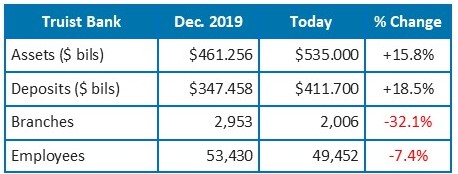Last year, over 300 banks shed in excess of 1,500 branch offices. Three Big Banks, Wells Fargo Bank, PNC Bank, and Truist Bank, with a combined net loss of 650 branches, were responsible for 40% of those lost branches.
When Big Banks shutter unwanted branches, they leave openings for more community banks. In this issue of Jumbo Rate News we look at just a few of those community banks that are taking advantage of voids left by the big banks.
In addition, all banks with a net decrease of four or more offices during the year can be found on page 5 of this week's issue of Jumbo Rate News.
Bank Branch Closures Exceeded 1,500 in 2023
During calendar 2023, over 300 banks shed in excess of 1,500 branch offices; those with a net decrease of four or more offices during the year can be found on page 5. Notice the first three: 4-Star Wells Fargo Bank, 4-Star PNC Bank, and 5-Star Truist Bank, with a combined net loss of 650 branches, represent over 40% of the total lost.
Wells Fargo shuttered 323 branches. Roughly 20% of them were in California, with Texas running in a distant second place. For those accustomed to having a Wells Fargo branch nearby, you probably still do. The bank still operates through more than 4,400 branch offices in all but a handful of states.
Wells Fargo Bank, N.A. is still the third largest U.S. bank by assets and one of just four with assets exceeding $1 trillion.
PNC Bank, the sixth largest bank in the nation (by assets), had a net loss of 207 branches (closing 240, but opening several others). The states hardest hit by PNC closures were: Maryland with 51 lost branches, New Jersey with 42 and Virginia with 38 branch closures. Along with those branches, PNC lost roughly 2,000 employees. Its asset size has remained virtually unchanged.
Then we come to Truist Bank. We knew it would divest 30 overlapping branches and more than $2.4 billion in deposits as a result of the merger of SunTrust and BB&T. That was a requirement of the approval.
According to that same approval, the combined bank “would operate 2,953 branches in 17 states” plus the District of Columbia. In its first quarterly financials as Truist Bank (December 31, 2019), it reported total assets of $461.256 billion and total deposits of $347.458 billion and employed 53,430 people.
Now, in spite of closing nearly one-third of BB&T’s/SunTrust’s branches, Truist Bank has reported healthy growth in both assets and deposits. It has decreased the number of people it employs, but by far fewer than the number of lost branches would suggest.
Truist Bank currently ranks 8th by asset size in the U.S., yet it managed to avoid the merger scrutiny afforded to Big Banks. At the time of its merger approval in 2019, Truist was projected to have (far) less than 10% of the deposit market share in the markets it serves. It did, but here’s a synopsis of changes since:
Truist Bank’s transformation is not complete yet, either. We expect about 70 more branch closures in the first quarter and probably more as the year progresses.
You know us by now, always looking for a silver lining. Here it is. When Big Banks shutter unwanted branches, they leave openings for more community banks. That’s good news for the people who live there. Here are just a few that are taking advantage of voids left by the big banks on page 1.
For example, in California, 5-Star Golden Valley Bank, Chico, opened a new office in Oroville, CA last fall and 5-Star Montecito B&T, Santa Barbara opened two new offices: one in Santa Maria last January and a second in Oxnard in December. All three cities already had lots of big banks to choose from, now they have a new local bank as well.
In Maryland and New Jersey, where PNC pared back its offices, we have 4-Star Shore United Bank, Easton, MD, which purchased the office of Community Bank of the Chesapeake, Waldorf, MD in July and 4-Star First Bank, Hamilton, NJ, which opened three brand new offices last year: one in Fairfield, NJ and one each in Paoli and West Chester, Pennsylvania.
In Texas, five community banks added two branches each during calendar 2023: 5-Star Frontier Bank of Texas was established in 2007 in Elgin (Bastrop County), TX. About three years later, it opened its second office in Bastrop. Then, in 2018, it expanded into the Austin area. That was followed up in 2019 with further expansion; this time into Williamson County. In 2022, it opened its second Williamson County office and its seventh total office. Last year, it added two more offices in Williamson County: one in Taylor and the other in Georgetown, TX.
5-Star First National Bank of Central Texas, Waco added two new locations, bringing its total to seven. The first, a full-service brick and mortar office in Gatesville, opened in April and then in June, it opened a loan production office in College Station.
4-Star Jefferson Bank, San Antonio, TX, was established in 1946, shortly after the end of WWII. Its goal was to serve the underserved in San Antonio. Its goal hasn’t changed, but its reach has. After adding new branches in San Antonio and Austin in 2023 (and bringing its branch count to 14), Jefferson Bank can share its expertise with more of the Lone Star State.
5-Star West Texas NB, Midland, TX has been serving West Texas for decades. The addition of offices in Plainview and Lubbock in 2023 brought its branch count up to 13. Last year also saw 4-Star Texas Security Bank, Dallas bring its branch count to five with a fourth full-service office in Dallas and its first outside of Dallas, in Tarrant, Texas.

